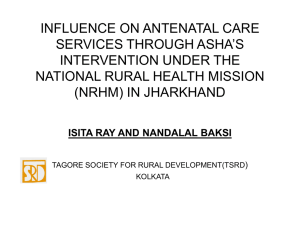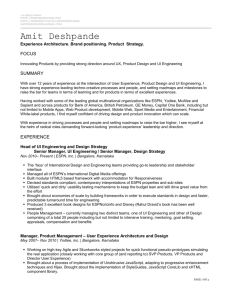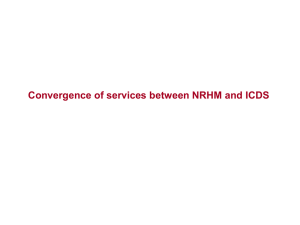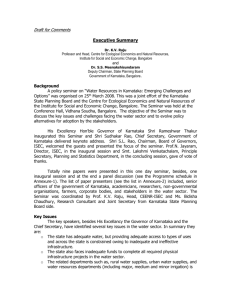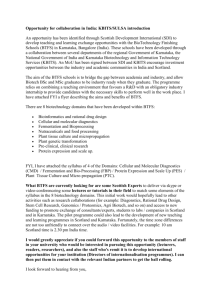Phase I Report: Site visit to Bangalore, Mysore
advertisement
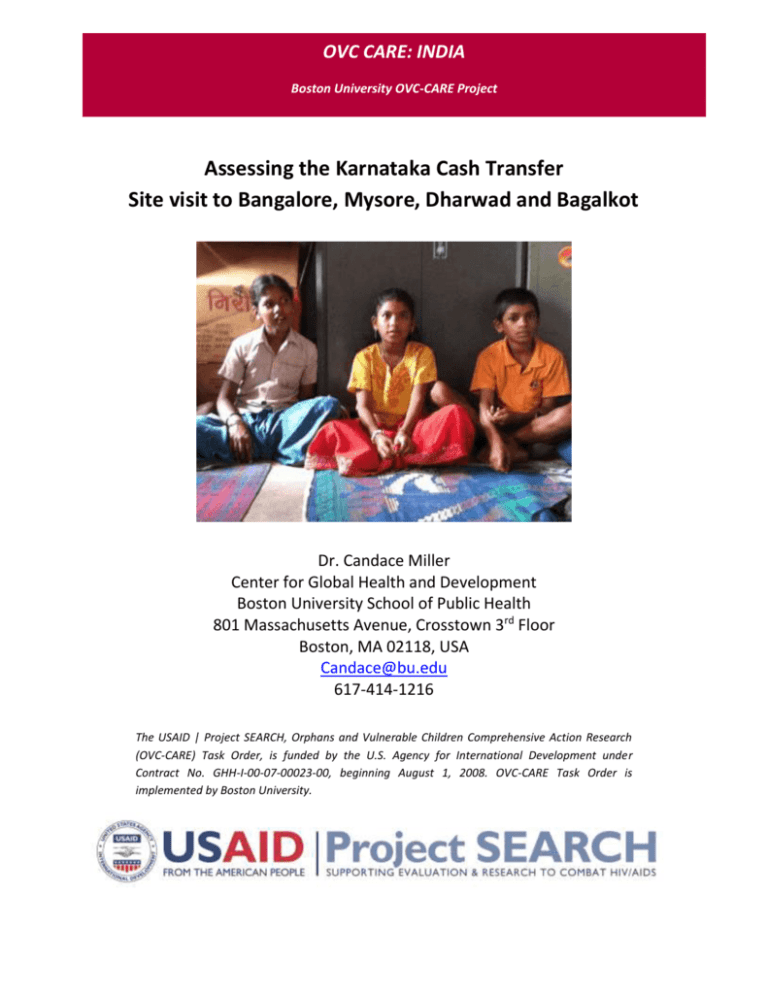
OVC CARE: INDIA Boston University OVC-CARE Project Assessing the Karnataka Cash Transfer Site visit to Bangalore, Mysore, Dharwad and Bagalkot Dr. Candace Miller Center for Global Health and Development Boston University School of Public Health 801 Massachusetts Avenue, Crosstown 3rd Floor Boston, MA 02118, USA Candace@bu.edu 617-414-1216 The USAID | Project SEARCH, Orphans and Vulnerable Children Comprehensive Action Research (OVC-CARE) Task Order, is funded by the U.S. Agency for International Development under Contract No. GHH-I-00-07-00023-00, beginning August 1, 2008. OVC-CARE Task Order is implemented by Boston University. OVC-CARE India Work Plan 2/18/2011 Table of Contents Map of Karnataka.......................................................................................................................................... 3 Acronyms ...................................................................................................................................................... 4 Methods ........................................................................................................................................................ 5 Context .......................................................................................................................................................... 5 Leadership ..................................................................................................................................................... 5 Policy debates ............................................................................................................................................... 6 Collaboration................................................................................................................................................. 6 Design............................................................................................................................................................ 6 Possible Linkages........................................................................................................................................... 7 “Hidden agenda”........................................................................................................................................... 7 Targeting ....................................................................................................................................................... 7 Benefits ......................................................................................................................................................... 8 Implementation ............................................................................................................................................ 8 Current operations........................................................................................................................................ 8 Ongoing activities.......................................................................................................................................... 9 Concerns by group ........................................................................................................................................ 9 Conditions ..................................................................................................................................................... 9 Scale up of Cash Transfer ............................................................................................................................ 10 Monitoring and evaluation ......................................................................................................................... 10 Capacity Building ......................................................................................................................................... 10 Impacts........................................................................................................................................................ 10 Grievance procedures ................................................................................................................................. 11 Sustainability ............................................................................................................................................... 11 Strengths ..................................................................................................................................................... 11 Weaknesses ................................................................................................................................................ 11 Opportunities .............................................................................................................................................. 12 Threats ........................................................................................................................................................ 12 Research and evaluation questions ............................................................................................................ 12 Citations ...................................................................................................................................................... 13 Annex 1 ....................................................................................................................................................... 14 2 OVC-CARE India Work Plan 2/18/2011 Map of Karnataka 3 OVC-CARE India Work Plan 2/18/2011 Acronyms ART Center Antiretroviral Center AHSA Accredited Social Health Activist ANM Auxiliary Nurse Midwife AWW Anganwadi Worker CDPO Child Development Program Officer KHPT Karnataka Health Promotion Trust KSAPS Karnataka State AIDS Program ICDS Integrated Child Development Service VHC Village Health (and Sanitation) Committee WCD Women and Child Development 4 OVC-CARE India Work Plan 2/18/2011 Karnataka Cash Transfer Karnataka, India Methods In July 2011, Dr. Candace Miller conducted interviews in Karnataka India for two weeks in order to document key aspects of the Karnataka Cash Transfer, including program design, activities, the targeting strategy, delivery mechanisms, frequency and level of benefits, scale up plans, sustainability, linkages to other programs, and other implementation issues. The research activities included key informant interviews and focus group discussions with stakeholders at the national, district, and village levels. Dr. Miller met with representatives from the Karnataka Health Promotion Trust (KHPT), the Directorate at the Women and Child Development, District Executive Officers and Deputy Directors of Women and Child Development at Districts, Child Development Program Officers, Gram Panchayatts, workers from Voluntary Counseling Centers, Village Health and Sanitation Committees (VHC or VHSC), Anganwadi workers (AWW), Accredited Social Health Assistants (ASHA), Auxilary Nurse Midwives (ANM) and their supervisors and KHPT link workers. Key informant Interviews and Focus Group Discussions took place in Bangalore, Mysore, Hubli/Dharwad and Bagalkot (see Annex 1). Information from this study will be used to assess program quality, sustainability and provide information for further scale up. Context Karnataka is one of the five states in India most affected by HIV. In 2009, HIV prevalence was 1%-1.9% across the 30 districts.1 In Karnataka, most orphans and vulnerable children (OVC) do not receive support, despite their needs. In communities, stigma and discrimination of people living with HIV//AIDS and their family members is still a serious issue that undermines efforts to care and support this population. Moreover, despite existing program and policies, many stakeholders agree that the “government machinery does not always work for children.” As a result, a new mandate has emerged, which is a collaborative response to identify and support children infected and affected by HIV/AIDS. Leadership Leadership for the response to children infected and affected by HIV/AIDS comes from the USAID funded Karnataka Health Promotion Trust (KHPT), the Karnataka State AIDS Program (KSAPS), the State Women and Child Development Ministry (WCD) and the National Rural Health Mission. The response to infected and affected children has been about two years in making, with the policy choice evolving after several programmatic attempts and ongoing learning and collaboration. 5 OVC-CARE India Work Plan 2/18/2011 Policy debates The early policy debates focused on the institutionalization of infected and affected children. However, this approach was piloted and observed. Stakeholders found this approach to be harmful to children. When children are taken from the homes of surviving parents, grandparent or aunt/uncles, they are separated from their siblings, village, and schools. Policymakers and implementers observed how children were emotionally distraught for two weeks after a monthly family visit. Furthermore, the financial allocation was not sufficient to pay for housing and staff; as well as the child’s nutrition, health, and education costs. Another policy option was the food and nutrition supplement provided to the infected or affected child only. This effort, funded by the Clinton Foundation, was a one year pilot project. However an evaluation showed that the food support was not effective because the food support was too small. When the meager food supply was spread throughout the family, the nutrition intervention yielded no change in children over time. Following these two efforts, policymakers, in consultation with communities, moved to a cash transfer to support infected and affected children in family care. In 2010, the government of Karnataka allocated 1 crore for the transfer program (approximately US$222,300). Collaboration Sensitizing stakeholders and obtaining “buy-in” for the Karnataka Cash Transfer was a collaborative effort between the Karnataka Health Promotion Trust (KHPT), Voluntary Counseling & Treatment Centers (VCT) and multiple levels of government including the Ministry of Women & Child Development (WCD) at the national level; Executive Officers and the Deputy Directors of Women and Child Development at the District level; Child Development Program Officers (CDPO), Gran Panchayats, and Village Health Committees (VHC) at the village level; and finally, Link workers, Accredited Social Health Activist (ASHA), Angawadi workers (AWW), and Auxiliary Nurse Midwives (ANM) within communities. Design The Karnataka Cash Transfer provides cash to families to support orphan and vulnerable children that are infected or affected by HIV. The program fits with and compliments the Integrated Child Development Service developed and implemented by the Ministry of WCD. With the cash scheme, ART clinic lists are used to identify eligible children (other programs rely on people seeking out benefits). Community level front line workers conduct Family Health Assessments. Initially KHPT and the VCT link workers conducted all assessments; however the responsibility of identifying children and families in need as been handed over to village level AWW, ASHA, and ANM. Once families are identified and assessed, the households are approved by Village Health Committees (VHC), Gram Panchayats, Child Development Program Officer (CDPO), District WCD, and finally, the Executive Officer. Next, funds are released to Districts by the WCD 6 OVC-CARE India Work Plan 2/18/2011 Directorate at State. Funds are transferred to CDPOs and VHCs to be deposited in recipients’ accounts. Possible Linkages Once the cash transfer scheme is fully established, the front-line workers (i.e. AWW, ASHA, and ANM) responsible for building relationships with families, conducting the Family Health Assessments and monitoring how families use the cash transfer, may also be able to link families to other supports available through the National Rural Health Commission. Linkages may include nutrition and medical supports, counseling, ARV provision; connections with the education sector to reintegrate out of school children back into school; and to other services within the Integrated Child Development Services (ICDS) through the Department of Women and Child Development. The cash transfer program creates the mechanism by which families can be connected to the appropriate supports without duplication of programs and services. “Hidden agenda” Scheme designers described how the Cash Transfer Scheme has two hidden agendas, including 1) reducing HIV stigma and discrimination, which can be reduced as infected and affected children are adequately cared for within family structures. They will be able to be cared for adequately so that their HIV status is not obvious or a limiting factor in their lives. The second agenda is for the scheme to eventually be extended to all orphans and vulnerable children in need, regardless of HIV status. While separate programs do exist for children (e.g. school uniforms, lunch programs, and free health services) and special programs for scheduled castes and tribes and ex sex workers, many of these programs are under-utilized due to limited knowledge and few referrals. The Cash Transfer Scheme can change this as ASHA, AWW, and ANM become aware of children’s needs. Targeting The Karnataka Cash Transfer is targeted to households with children aged 0 to 18 years who are infected or affected by HIV/AIDS. Additionally, the child and family must be in need of cash support. Families do not have to show a BPL “Below Poverty Line” certificate because it is often a difficult and lengthy process to obtain these certificates. Households will be reassessed annually to determine ongoing need. However, in order to be considered during the first Family Health Assessment, the family must have been registered with an ART clinic. These families must consent to home visits and allow the community worker to do the assessment. If a family and child are affected by HIV/AIDS, but are not registered with the ART clinic, they will not be assessed. 7 OVC-CARE India Work Plan 2/18/2011 Benefits The cash benefit of the Karnataka Cash Transfer was set in 2009. Families may receive up to 800 Rupies per month per child. The Foster care benefit, which is cash to a household caring for a non-biological orphan, is R750. The Sponsorship benefit, which is cash to a household caring for their own child (such as by the biological mother or father or grandparent) is R650. Families may also receive cash for nutrition, education, and housing. However, the per child total benefit may not exceed R800 per month per child. The amount of money is determined by the AWW, ASHA or ANM worker during the Family Health Assessment process. Implementation The implementation of the Cash Transfer Scheme includes the following activities: 1. Ongoing sensitization of District and Community officers (Executive Officer, District Officials, etc.) 2. Training of ASHA, AWW, ANM, CDPO, Village Health Committees and Gram Panchayat (GP)) 3. ARV Centers provide family names to WCD 4. AWW, ASHA and ANM complete family health assessments; build rapport with families; link to other services 5. CDPO, GP, District WCD, and Executive Officer sign off on assessments 6. Money transferred to districts 7. Households receive cash in their bank accounts 8. Ongoing monitoring of how money is used 9. Regular auditing of District accounts To date, all activities have occurred with support and technical assistance from KHPT. Current operations As of July 2011, 14 districts are implementing the Cash Transfer Scheme or are ready to implement. However, within these districts, not all Taluks (administrative units) are ready to implement. In fact, only the Taluks where KHPT has worked have been fully sensitized to the Cash Transfer Scheme. For example, in Bagalkot 2/6 Taluks have been trained. The training plans have been articulated, but they must still be implemented. Moreover, there are 16 districts remaining to be trained and sensitized before the Cash Transfer Scheme can be launched. While many districts and Taluks have completed the Family Health Assessments, still only a few families are receiving the transfer as of July 2011. Money has been held up at the District level or CDPO as officials wait for official directions to disburse funds. Finally, the scale up of the Cash Transfer Scheme could be hampered where ART centers are hesitant to give client lists to government. The ART centers worry that it would be a breach 8 OVC-CARE India Work Plan 2/18/2011 of confidentiality to give client lists to the District WCD department, despite the fact that children and families would receive benefits. In Taluks where the scheme is operational, the WCD has the lists because they have signed off to pay these families. Ongoing activities The need for sensitization of EOs, Gran Panchayats, CDPO, Village Health Committees, AWW, ASHA, families is ongoing given the election cycle and employee turnover. Again, sensitization action plans have been developed for some Taluks. Still, capacity building and technical assistance was universally requested by District Women and Child Development in order for them to fully and effectively implement the scheme. Concerns by group The following concerns were expressed by stakeholders at the different levels: Stakeholders State Government Executive Officers & District Officials Zilla & Gram Panchayatt Concerns One major advocate involved from beginning; without Deputy Director WCD, program is at risk Responsible for 30-60+ other programs; if not sensitized, will not support CDPO Supportive of program; could possibly take on financing in future if impact is positive; sensitization needed in new Taluks, Districts Concerns about releasing cash; Not sure how to monitor program Village Health Committee AWW, ASHA, ANM (often same as Gram Panchayatt); Have many programs; this is relatively small; Also not clear how to monitor program Have other responsibilities; low pay, need ongoing sensitization; KHPT Provided ongoing Technical Assistance but is closing out project, leaving major gap in implementation technical expertise Conditions There are no behavioral or spending conditions attached to the Karnataka Cash Transfer; however it is expected that the money will be used to improve the child’s nutrition, health and educational outcomes. However, many have concerns about how families will use money and wonder: “Will the cash be used for children?” While not currently being considered, conditions might be acceptable and helpful to achieve program goals. 9 OVC-CARE India Work Plan 2/18/2011 Scale up of Cash Transfer If the Karnataka Cash Transfer is to be scaled up throughout Karnataka, NGO technical assistance is required throughout the 14 districts where the program has been launched and more especially in the 16 outstanding districts. Stakeholders universally agree that there will be an important gap without KHPT providing technical assistance and support. Specifically to scale up throughout Karnataka, the Cash Transfer must be expanded to include 30 Districts, which contain 27 Zilla Panchayats, 175 Taluk Panchayats, and 5659 Gram Panchayats. Additionally, several problems must be overcome, such as Cash Transfers being stuck at Districts because some District Officers are still unsure of the program, the EO or Deputy Director WCD is still requesting a letter from the WCD Directorate at the state level to proceed, and CDPOs must be instructed to release funds. Nevertheless, funding for the Cash Transfer is available through state government so hopefully the implementation and scale up challenges will be overcome. Monitoring and evaluation As of July 2011, the program has just been launched and there were no monitoring and evaluation activities under way, nor had an M&E plan been developed. The Districts do ¼ to ½ year financial audits, but these do not encompass program or beneficiary monitoring implemented. Ideally, a monitoring system will be articulated where activities and beneficiaries are frequently monitored, and problems are flagged so that they can be addressed swiftly and early. An adequate monitoring system can ensure that program activities are implemented and impacts are achieved. Implementers can ‘course correct’ before the Cash Transfer Scheme gets far off track. At the community level, AWW, ASHA, ANM and VHC members are willing to monitor, however with low capacity for monitoring and using data to course correct, training and technical assistance is essential. Capacity Building Technical assistance and capacity development are essential to help build an M&E system for the Karnataka Cash Transfer Scheme; to train all AWW, ASHA, ANM, VHC, District WCD officers, and to manage and utilize monitoring data. Impacts It is still unclear what the program impacts will be given that the program has just been launched. In Mysore, where families have begun to receive cash, there are anecdotal reports of families enjoying improved nutrition (including high quality proteins and dairy), improved ability to send children to school, improved health, confidence that they will have a “good life”, and concerns over confidentiality and disclosure of the child or family members HIV status. 10 OVC-CARE India Work Plan 2/18/2011 Grievance procedures The Karnataka Cash Transfer Scheme does not have its own, separate grievance procedures, but rather will be reliant upon the regular government Panchayat procedures, whereby District officers visit villages monthly in order to hear grievances. The time and meeting location where citizens can submit grievances is set in advance and communicated. These procedures are often used for other programs and are generally considered an effective way for community members to have grievances heard and rectified. Given that this scheme is linked to the child’s infected or affected status, stigma and fear of disclosure may inhibit families from engaging in the process. However, once the Cash Scheme is established, this system should work for this program. Sustainability The sustainability of the Karnataka Cash Transfer Scheme is still unclear given that KHPT, the main technical assistance provider, is closing out their final contract year. It is not clear, in the absence of KHPT, who will write proposals, manage the scale up, validate data, map and update info. The Karnataka Cash Transfer Scheme is just one of many government programs that is unlikely to continue without NGO support. Nevertheless, sustainability depends upon the program’s positive or negative program impacts; whether training and sensitization continues, and whether government has NGO support. Strengths The Karnataka Cash Transfer Scheme has many important strengths including the following: First, the Karnataka Government wants this scheme to continue. There is a nearly universal perception that fraud and corruption is unlikely because of many bureaucratic layers. The policy option is child-friendly whereby children remain at home without any sibling separation. Stakeholders believe the program design will help maintain the dignity of the child and family because the HIV status does not have to be disclosed at the community level and families do not have to beg for assistance. Community workers identify families within villages who often do not come forward on their own. Moreover, the scheme has been community driven with a bottom up design and ongoing community consultations. Finally, the Karnataka Cash Transfer Scheme is evidence based, drawing upon the literature on cash transfers and experience based, as stakeholders explored policy alternatives and then designed this program and made adjustments to the design as needed. Weaknesses The Karnataka Cash Transfer Scheme also has weaknesses that must be addressed. Still, despite ongoing efforts, there is still a high level of sensitization required for community workers, elected officials, and district officers. The Karnataka Cash Transfer Scheme may lead to 11 OVC-CARE India Work Plan 2/18/2011 HIV disclosure, stigma, and discrimination if information is not handled confidentially. Also, there are many layers of approvals necessary, which may reduce corruption, but could also cause bureaucratic delays. Additionally, the community workers (AWW, ASHA, and ANM) have limited education, low pay, and many competing responsibilities so their ability to prioritize or simply carry out activities for this program, without incentives, may be limited. Moreover, the children from families that are not registered as ART center clients may be overlooked despite their needs. Another issue is that the Karnataka Cash Transfer Scheme is implemented slightly differently across districts, which may yield differences in the quality of implementation. The Scheme may soon need updating as the Family Assessments were completed and the transfer value set in 2009. There have been no subsequent updates despite the evolving situation of families and inflation. Finally, from the time when Family Assessments were completed to when cash is first delivered is still way too long such that children and families have important unmet needs. Opportunities Once the Karnataka Cash Transfer Scheme is launched and is operating effectively, it could be expanded to include all OVC and all children in need. Every AWW, ASHA, ANM and VHC member knows of additional children in community needing a transfer too; however if children do not meet the program guidelines they are not currently included. Still, in the future, this program could link well with all other programs to ensure comprehensive supports to all children in need, while avoiding duplication and exclusion. The Karnataka Cash Transfer Scheme utilizes a well designed assessment procedure with community input so this process can be replicated and utilized for other coordinated programs. Additionally, if implemented well, it could reduce HIV stigma over time. Threats The treats to the Karnataka Cash Transfer Scheme include the fact that stigma and fear of disclosure may keep families from joining the scheme. One suggestion is to broaden the scheme for all orphans (OVC implies HIV) to reduce HIV stigma. Of course, framing the transfer for “all orphans” means more will children and families will be eligible, creating budgetary implications and possibly concerns about the program size. Another threat is that if AWW, ASHA, ANM re not well trained, they will not utilize the program. Finally, if lack of awareness and sensitization of program persists, the risk of abandonment is real Research and evaluation questions Several research and evaluation questions should be answered as the program is launched and scaled up. For example, 1) Will all eligible children be identified? What are the errors of 12 OVC-CARE India Work Plan 2/18/2011 inclusion and exclusion? 2) How much money will reach families? 3) How will families use money? 4) What are short and long term impacts of cash within families and communities? Citations 1. Karnataka State AIDS Program (KSAPS). (2011) Annual Action Plan Online at http://stg1.kar.nic.in/ksaps/AAP_2011-12_Karnataka_June_28th,_2011_PDF.pdf. Accessed July 29, 2011. 13 OVC-CARE India Work Plan 2/18/2011 2. Annex 1 Name Troy Cunningham Mr Vishwanath Mr Ashokanand Dr Manish Kumar Ms Narmada Anand Dr Bharat Shetty Srikante Gowda Mysore District Mysore District Village Health and Sanitation Committee Angawadi (AWW), Auxiliary Nurse Midwives (ANM) and ASHA workers Cash Transfer beneficiaries Mr Venkatesh Sabnis AWW, ASHA, ANM Usmali Village Sanitation Committee Executive Officer DD, WCD (Assistant) CDPO DD, WCD (Assistant and Director) CEO ZP – Ms Tejswini AWW, ASHA, ANM CDPO Link workers 2 Orphanages in Bagalkot Home organization Engender Health KPHT KHPT, 28 years Indian Administrative Services Deputy Chief of Party Deputy Director Women and Child Development KHPT CEO Mysore KHPT Director Women and Child Development District Aids Director, District Supervisor VHC, District CDPO (All at Executive Office) Mysore, Gram Panchayat Mysore, Gram Panchayat Mysore (were at KHPT office) Hubli KHPT Hubli, Gram Panchayat KHPT Hubli, Gram Panchayat Hubli District Government, Zilla Panchayat Dharwad/Hubli Dharwad Bagalkot Dharwad and Bagalkot KHPT Bagalkot Bagalkot Bagalkot KHPT Bagalkot Because orphan facilities are main policy alternative to cash transfers 14



